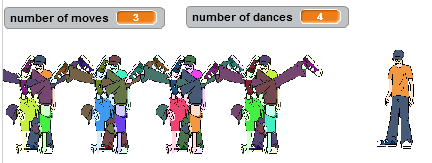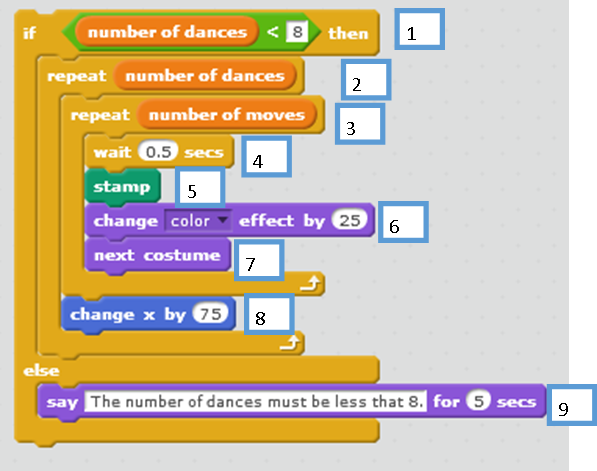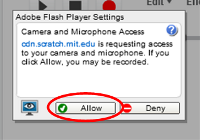
Summary:
Students use a partially completed project that asks how many times a sprite should move in one dance and how many times the sprite should perform the dance. When all the dances are complete, the sprite asks how many moves it made in all of its dances. In the example shown in this picture, the sprite had 3 moves in each dance and danced 4 times. 3 x 4 = 12. The sprite made 12 moves total in its 4 dances.
Materials:
- Dance and Moves Scratch activity (teacher version)
- Dance and Moves Scratch activity (student version)
- Scratch Activity Dance Complete Teacher Demo
- Copies of Scratch Blocks and Partial Scripts Part 1
- Copies of Scratch Blocks and Partial Scripts Part 2
- Copies of Scratch Blocks and Partial Scripts Part 3
- Copies of Scratch Blocks and Partial Scripts Part 4
- Scissors and glue sticks
- Classroom computer and student computers
Programming Skills with Scratch:
- Open, remix, save, and share a Scratch project
- Complete a partial script
- Set a variable to the answer of an ask and wait block
- Nest repeat blocks inside if_ then_ else blocks
- Nest a less than block with a variable as an input into an if_ then_ else block
- Nest a multiplication block with variables and an answer block into an equal block
- Change a sprites position using a change x by block and a go to x: y: block
- Scratch blocks used: (less than, multiplication, clear, stamp, set variable to, ask and wait, answer, repeat, repeat until, if_ then_ else, wait, change color effect by, say, switch costume to, next costume, go to x: y:, change x by)
Lesson:
- Open and discuss the completed Dance and Moves link.
- Try the activity several times using different numbers for the number of moves and the number of dances.
- Explain that in this project the script is divided into 4 main parts.
- Pull the script apart to look at part one shown below. Discuss what each block does. Each are explained below.
- Allow time for students to complete Scratch Blocks Part 1 with a partner or alone.

- Pull the script apart and look at part two shown below. Discuss what each block does. Each are explained below.
- Allow time for students to complete Scratch Blocks Part 2 with a partner or alone.

- Blocks 1 and 3 asks for input about the number of dances and the number of moves in each dance.
- Blocks 2 and 4 set already created variables to the number of moves and the number of dances given as the answer to the ask and wait blocks.
- Pull the script apart and look at part three shown on the follow page. Discuss what each block does. Each are explained below.
- Allow time for students to complete Scratch Blocks Part 3 with a partner or alone.

- Block 1 is a conditional block. If the number of dances is less than 8 then the sprite will dance. Else, if the number of dances is 8 or greater the sprite will say, “The number of dances must be less than 8.” Try changing this input to allow for more than 8 dances. Change 8 to 10. Try the script and ask the sprite to dance 9 times. Notice that the sprite does not have room on the stage to dance more than 7 times.
- Block 2 tells the sprite to repeat the dance the number of dances given as the input in the ask and wait block in part 2 of the script.
- Block 3 tells the sprite to do the number of moves given as the input in the ask and wait block in part 2 of the script.
- Block 4 tells the sprite to wait .4 of a second between each move.
- Block 5 tells the sprite to stamp.
- Block 6 tells the sprite to change colors. This helps you see each of the move the sprite makes. Try taking it out. Without this block, it is difficult to see each of the moves.
- Block 7 tells the sprite to switch to its next costume.
- Block 8 moves the sprite 75 steps between dances. Without this the sprite would dance all the dances in the same place. Try removing this block. Notice it is not easy to tell how many times the sprite danced.
- Block 9 tells the sprite what to say if there are too many dances requested. Remember too many dances will not fit on the stage area.
- Pull the script apart and look at part four shown on the following page. Discuss what each block does. Each are explained below.
- Allow time for students to complete Scratch Blocks Part 4 with a partner or alone.

- Block 1 moves the sprite to a new location after it has finished all of its dances.
- Block 2 changes the sprite back to its original costume.
- Block 4 ask, “How many moves did I have in all my dances?” This problem is solved with a multiplication problem. Multiply the number of moves in each dance by the number of dances in all. In the example shown at the beginning of this lesson, there were 3 moves in each dance and 4 dances. 3 x 4 = 12. So the answer for that example is that the sprite had 12 moves in all of its dances.
- Block 4 uses variables to show the multiplication steps. Variables are used because the input to the ask and wait blocks in part 2 could be any number. The answer to the question in block 3 must equal the number of moves times the number of dances. This block says that the answer to the question in block 3 must be correct before the sprites does the step shown in block 6.
- Block 5 tells the sprite what to say something each time the answer is incorrect. The sprite will say, “No, that is not correct. Try again?” It repeats until the answer is equal to the number of moves times the number of dances.
- Block 6 tells the sprite to say, “Yes.” This will only happen when the input given in block 4 equals the correct answer.
- Decide if you want students to work with a partner or individually.
- Ask students to open, remix, and compete the partially completed link to Dances and Moves Scratch activity (student version)
- This is a partially completed script.
- All the blocks needed to complete the script are already shown in the script area.
- Student should use the worksheets they completed for parts 1, 2, 3, and 4 to complete the script.
- Students should test their script when they are finished.
Extensions:
- Ask student to add sound to their project. The music should play while the sprite is dancing.

- Click the Sounds tab.
- Click the horn icon to open the Sound library.
- Click on a sound.
- Click the triangle to hear the sound.
- Use blocks from the SOUND category to play the sound in a sprites script area.
- Ask students to open the link to the Dance Complete Teacher Demo project
- This project uses conditional statements to control the sprite. Student either clap their hands or shake their head to make the sprite dance and move.

- Students will have to click allow if this message appears on their screens. This allow Scratch to use the computer’s camera and microphone.
- Allow time for students to explore this project. Ask them to look for a if_ then_ , else conditional. Ask them to explain that conditional to a partner.
- This project uses conditional statements to control the sprite. Student either clap their hands or shake their head to make the sprite dance and move.
Optional Unplugged Activity:
Common Core:
3.OA, 3.NF, 3.MD
CT/CS Standards and Skills:
CT—Decomposition,
CS– write programs that accomplish specific goals, use sequence in programs, work with various forms of input/output, Conditional (if_then, else)





These lessons were written by Judy Rocke based on lessons developed at Kenwood Elementary School in the Champaign Unit 4 school district. Funding was provided by the National Science Foundation under award number 1542828. These lessons are intended to be used alongside the EM-4 curriculum.
Lessons prepared as web documents in Summer 2017. Contact us for updated lesson plan materials.
Lessons prepared as web documents in Summer 2017. Contact us for updated lesson plan materials.
